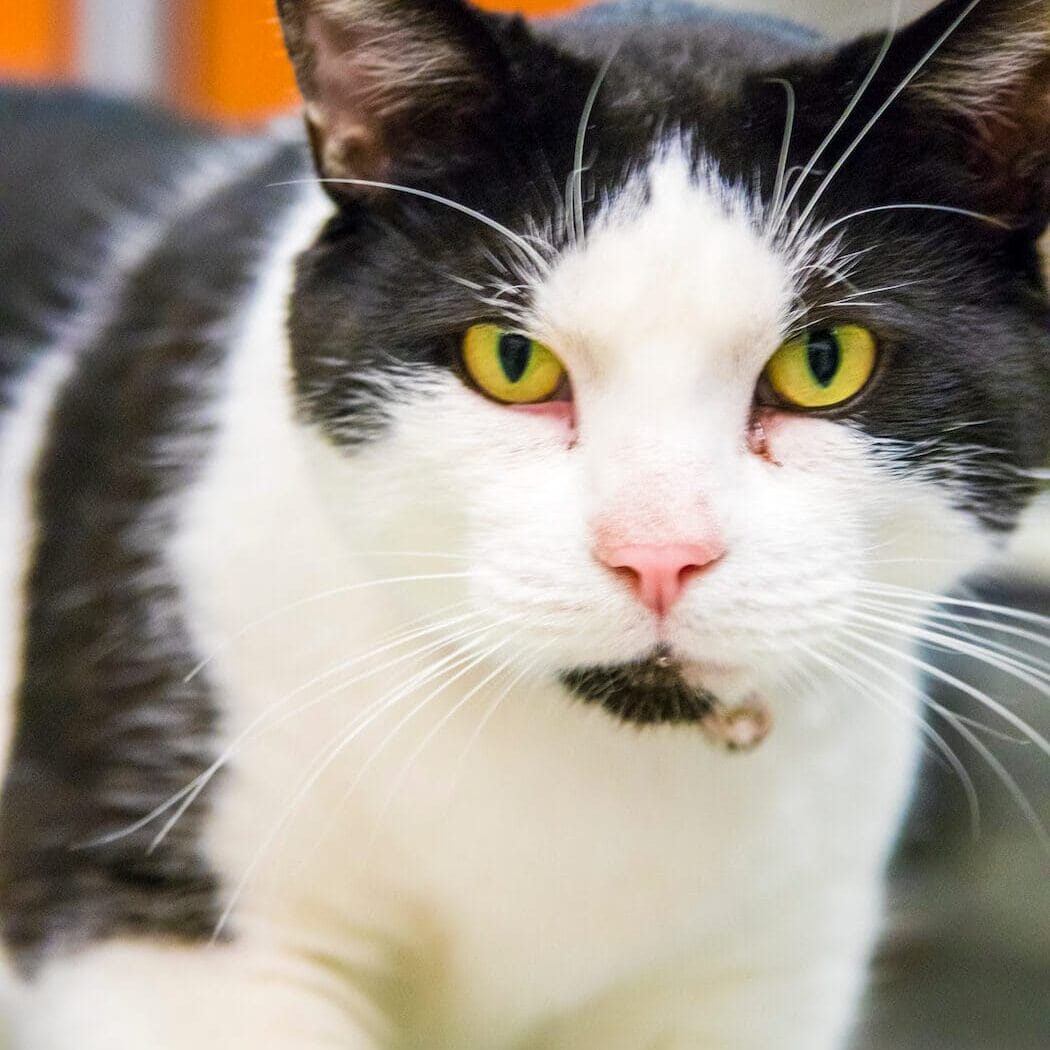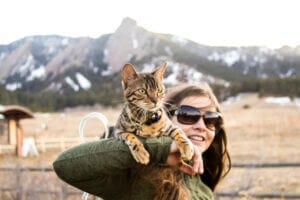
Kneading, what cat lovers refer to as “making biscuits,” is a behavior seen in domestic cats where they push in and out with their front paws, often alternating between left and right like kneading dough. This action is usually performed on soft surfaces like blankets, pillows, or even their human’s lap. But, why do cats knead their paws in the first place? Learn the reasons cats knead and where the behavior comes from.
Why Do Cats Knead Their Paws?
This cat behavior begins based on instinct. The origins of cat kneading can be traced back to kittenhood. When newborn kittens nurse, they knead their mother’s belly to stimulate milk flow. This instinctive behavior comforts them and promotes their survival.
As they grow older, cats often retain this kneading behavior, associating it with the warmth and comfort they experienced as kittens. Their body may also release a hormone called oxytocin which is a social bonding hormone, commonly known as the ‘love hormone,’ which can promote happiness and relaxation.
Cat Kneading With Just Their Front Paws
When cats knead, they typically use just their front paws shifting from left to right or vise versa. This action is deeply ingrained in their muscle memory. The movement is precise and deliberate, demonstrating their innate ability to use their paws effectively–a trait also seen in their amazing natural mousing skills.
Whether they’re kneading to get comfortable or jumping at a toy or real prey, cats show a lot of awareness and control with their paw movements. This ability has developed over many years, making them both good hunters and silly, fun companions.
Why Adult Cats Knead Blankets
Cats kneading blankets is a behavior that goes back to their earliest days and is tied to their natural instinct to seek comfort. When cats press their paws into a blanket’s soft fabric, it reminds them of the feeling they had as young kittens snuggling against their mother’s fur, even after kittens stop drinking milk.
This feeling, remembered through touch, brings back a sense of safety and emotional comfort. For cats, a soft blanket can take the place of the care and warmth they got from their mother when they were very young.
This behavior is not just about feeling good physically. It’s also about the emotional connection cats have with their early life experiences. The act of kneading can take cats back to a time when they felt completely safe and cared for as tiny kittens, which is important for their emotional well-being. This is why you might notice that cats often seem particularly content or even purr while kneading; it’s a comforting activity for them.
This kneading action is more than just a simple movement; it’s a complex behavior that involves both their instincts and learned behaviors. While the act of kneading is instinctual, the choice to knead a blanket specifically might come from the cat learning that certain textures and softness provide a comforting experience. In a way, cats use kneading as a method to recreate the nurturing environment of their kittenhood.
Cats Kneading For Nesting
In their natural habitat, the ancestors of today’s domestic cats used to knead down grass, leaves, or other natural materials to craft a soft and snug area for resting or giving birth. This behavior helped them create a comfortable, secure spot in the wild. Modern house cats have inherited this instinctual practice.
They often use their paws to press and manipulate blankets, pillows, or other soft objects in their environment, making these surfaces more welcoming and warm. This kneading action is similar to how humans might fluff up their pillows or bedding; it’s the kitten settling down by preparing their resting area to ensure it meets their comfort needs perfectly.
This kneading behavior in domestic cats is more than just a remnant of their wild past; it’s a practical adaptation to their current environment. While they no longer need to prepare a nest in the wilderness, the instinct persists, and they apply it to their domestic life. By kneading blankets or cushions, cats are not only making their sleeping area more comfortable but also engaging in a soothing, rhythmic activity that may promote calmness.
Cat Kneading for Attention
If your feline friend often climbs onto your lap and begins kneading, it’s possible they are doing so as a way of seeking attention or as a form of communication. This behavior is often reinforced by the responses they receive from you.
When your cat jumps onto your lap and starts kneading, if you typically respond by petting them, speaking to them in a soothing voice, or showing any form of affection, they perceive these actions as positive reinforcement. Cats are intelligent creatures and quickly learn which behaviors result in favorable responses from their human companions.
This positive correlation–the link between the action (kneading on your lap) and the reward (affection or attention)–encourages many cats to repeat this behavior. Over time, they come to understand that kneading is an effective way to gain your attention and affection. This is not just a random act; it’s a learned behavior that has been strengthened by the positive interactions that follow.
Plus, this behavior demonstrates the social bond between you and your cat. Cats are often viewed as independent animals, but they do form strong attachments with their owners and seek ways to express their affection and desire for closeness. Kneading on your lap can be a sign of trust and comfort from your cat’s perspective, showing that they feel safe and loved in your presence.
Additional Reasons Cats Knead
Additional reasons your cat may knead include:
- Marking with scent glands: Cats have scent glands on their paws that they use to mark their territory. When they rub their paws on something, they leave their scent behind for other cats to smell. That says ‘I’ve been here; this is my territory.’
- Relaxation time: Take a look at your cat’s body language. If you notice they have slow, blinking eyes, with a relaxed cat’s posture, they’re calm and may fall asleep.
- Stretching: Your cat may also knead to stretch their muscles. Kneading an object, or you, allows them to get in a good stretch.
- Mating: Cats in heat sometimes knead their paws in addition to to sticking their hindquarters in the air. You may notice them kneading an object or even kneading the air when they’re ready to mate.
Don’t Declaw Your Cat for Making Biscuits
Declawing, contrary to what some may believe, is not a solution for cats who knead with their claws. It is an invasive procedure that can lead to long-term physical and behavioral issues. Instead, appropriate measures such as providing scratching posts, keeping nails trimmed, and using soft caps on your cat’s claws can be more effective in managing the kneading behavior.
Keep Your Cat’s Nails Trimmed
If you find that your cat’s kneading is uncomfortable or even painful at times, or if you’re concerned about them damaging your furniture, regularly trimming their nails can be a great solution. When a cat’s nails are long and sharp, their kneading can unintentionally cause scratches on your skin or tear into upholstery and other fabrics. By keeping their nails well-trimmed, you reduce the risk of damage and make their kneading a more pleasant experience.
Redirect Behavior When Your Cat Kneads
If you’re trying to get your cat to stop kneading, don’t punish the behavior. You can make your cat fearful and damage the trust they have with you by doing so. Instead, cat owners can redirect their attention to something else, like a soft barrier or something else they approve of, using positive reinforcement training. You can encourage your cat to knead other objects and offer a treat or toy when they do. You may have to repeat this process a few times before they connect the reward with the stimulus.
Cats Kneading Excessively
Your cat could be kneading to promote calmness due to a new pet or person in the household, travel, a change in their routine, or an underlying health condition. Before you take any measures behaviorally, it’s important to talk to your vet and address their concerns accordingly.
If your vet clears your kitty, you can then move on to try to promote cat calming in other ways, like cat supplement. For example, full spectrum CBD Oil for cats benefits by:
- Helps animals maintain a normal and relaxed disposition
- Helps maintain contentment during separation, travel, motion sickness and tension caused by changes in your pet’s daily routine
- Helps maintain normal emotional balance
- Promotes a sense of relaxation and mental alertness without drowsiness
- Helps reduce the effects of normal environmental stress
By introducing full spectrum CBD for cats, you can promote calming for cats and make sure your kitty has a comfortable kneading experience.
For further reading, we recommend:
- https://www.cell.com/current-biology/fulltext/S0960-9822(19)31086-3?_returnURL=https%3A%2F%2Flinkinghub.elsevier.com%2Fretrieve%2Fpii%2FS0960982219310863%3Fshowall%3Dtrue
- https://www.aaha.org/your-pet/pet-owner-education/ask-aaha/is-my-cats-kneading-normal/#:~:text=Kneading%20to%20convey%20comfort%20%E2%80%94%20Happy,create%20a%20soothing%2C%20calm%20mood
- https://phys.org/news/2022-12-cats-knead.html
You Might Also Enjoy
Reactive dog barking may sound intimidating, but it’s important to differentiate it from dog aggression.…
Your dog’s skin is their largest organ making dog skin care a crucial part of…
Like us, our dogs, and other mammalian species, cats have an endocannabinoid system. This system…





